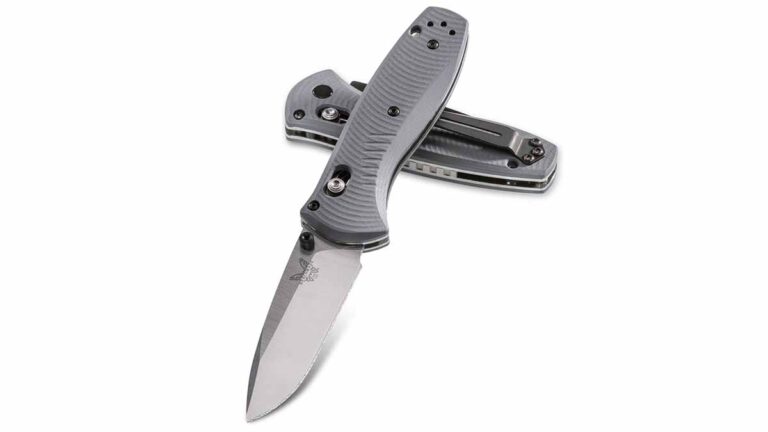
The Assisted-Opening Knife Is A Powerful Type Of Pocketknife Beloved By Blade Lovers Around The World. These 12 Stand Out From The Pack.
There are quite a few minor differences that separate various types of knives that are otherwise visually or externally indistinguishable. In the same vein as a sword is a sword or an axe is an axe, many people treat knives simply as a variation on a basic theme. In the case of assisted-opening knives, this has led to a great deal of confusion, and for the most part, a large amount of legal misunderstanding.
ORIGINS OF THE ASSISTED-OPENING KNIFE
The foundational designers of the assisted-opening knife modeled their mechanisms along very similar lines—mostly based on motorcycle kickstands. BLADE Magazine Cutlery Hall-Of-Fame® member Ken Onion is a well-known knife designer and was among the first to arrive at a mass-produced design.
While Onion was not the first, his basic design set the stage for what we have today. Before him, Cutlery Hall-Of-Famer Blackie Collins arrived at a design that was successful. There is a distinction at this point. Some assisted openers are described as “gravity knives” or “flick knives” and this is both true and false.
Some of the first successful gravity knife designs required the user to open the mechanism and the blade would slide down without spring assistance. Flick knives are generally undefined, but in general, require a flick of the wrist to deploy the blade either out the front or from the frame.
One of the most widely issued versions of this is from the Nazi German Air Force, where most aircrews in the Luftwaffe were given a type of out-the-front gravity knife. These became popular bring-back trophies and were oftentimes miscategorized as automatic or switchblade-style knives, and as flick knives.
The original German models never had a spring inside the mechanism. If they had, they would have qualified under modern law as an out-the-front automatic. This knife does deploy extremely quickly, often as fast as a spring-loaded variant.
These incorrect terms are bundled and grouped into the broad ‘bad knife’ generalization. The mechanical function of the assisted-opening knife is to finish opening the blade, not to deploy the blade on its own. This may seem like a minor thing but it is very important legally.
IS AN ASSISTED-OPENING KNIFE REALLY A SWITCHBLADE?
A relatively confusing aspect of this topic is what exactly constitutes a knife that falls into the dubious “switchblade” category, and what is an assisted-opening mechanism. The casual observer may not notice any difference in terms of function. In most cases, it appears that the blade simply pops out on its own from the handle.
The primary difference in this is that an automatic knife is self-actuated, usually with the push of a button. A knife that operates via an assisted-opening mechanism requires a person to start the opening process before the blade actuates and finishes opening itself.
This may seem like a trivial difference, but when it comes to skirting or working around restrictive laws, there is a great deal of importance that is occupied in that slight separation. We tend to see this in many cases where even cosmetic details can determine legality.
In 2009, there was a federal effort to clearly define and limit the number of restrictions that could be placed on knives that were determined to be of the open-assist and one-hand-opening variety, as opposed to those categorized directly as switchblades. 15 US Code 1224 Exemption 5 states that:
“A knife that contains a spring, detent, or other mechanism designed to create a bias toward closure of the blade and that requires exertion applied to the blade by hand, wrist, or arm to overcome the bias toward closure to assist in opening the knife.”
In other words, this defines an assisted opener as a knife that is designed to remain closed until acted upon, whereas a switchblade could thus be assumed to be a knife that is biased to remain open unless retained. These small variations in legalese are all we have that draw a line between what constitutes a legal assisted-opening knife and something reputedly “more inherently dangerous.”
HOW DO ASSISTED-OPENING KNIVES WORK?
As mentioned above in the legal definition of an assisted opener, the preeminent design feature is that the blade remains closed under a given mechanism until a force is applied to it. The mechanism necessary for a knife to accomplish this is quite complicated.
Not only must the blade be able to interact with an internal spring, but that spring also needs to generate enough pressure on a very small rotational axis to extend it to its final position and provide the energy to bypass the locking feature. This could be a linerlock or any number of locking mechanisms.
Because there are a tremendous number of functions being asked of this mechanism, they tend to become quite intricate, and for the most part, should not be disassembled by the owner. If something goes wrong with any type of assisted-opening knife, the owner should contact the manufacturer and get it repaired at the factory. Many of these mechanisms share more in common with watches and other fine pieces of machinery than they do with other knives.
There is a wide range of variation in terms of design from company to company. As a result, you will tend to see that, while assisted-opening knives are a general category, most manufacturers prefer to put their own spin on the terminology used to describe their product.
There isn’t a functional difference between what a company calls its design and what it accomplishes. What matters at the end of the day with assisted-opening knives is that they produce the same end result preceded by meeting the legal requirement of being an assisted opener. It doesn’t really matter if the mechanism is actuated by a thumb peg, flipper tab or wrist flick, the end result is the activation of the spring override forcing the blade to lock into the open position.
The basic design of most assisted-opening knives requires the blade to be manually opened at least 1/4-1/3 of its total travel before the spring takes over and opens it the rest of the way. This can be accomplished through numerous designs. The most common relies on an internal spring in the mechanism that resides on a cam, the latter interacting with the geometry of the rear of the blade surrounding the hinge pin.
Past a certain point, the shape of the parts allows the spring-loaded cam to interact with the gradual, declining angle of the back of the blade, thus forcing it open against the tension. Of course, this is just one way to describe how this works, and individual designers and companies will work around existing patents and models to create new ways to get the job done.
ARE ASSISTED-OPENING KNIVES LEGAL ACROSS THE BOARD?
The short answer to this is, yes, and no. In some states, it matters more how you carry the knife than what type of knife you were actually carrying. Michigan, for instance, allows the open carry of most knife types, regardless of features.
When it comes to carrying concealed, there are some murky definitions. In general, if a knife is visible, at least partially, such as in a front pocket, it is considered open carry. The vast majority of states allow everyday carry for assisted-opening knives. In fact, many states also allow the carrying of automatic knives as well.
Best Assisted-Opening Knives For The Money
While assisted-opening knives may not be for everyone, they are incredibly popular and made by manufacturers around the world. These dozen show off the breadth of models available on the market today.
Kershaw Cryo II
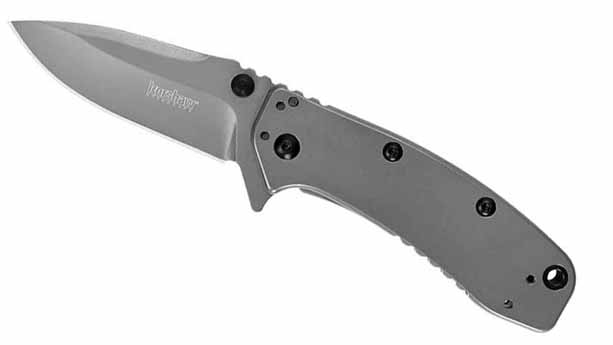
The Cryo II is a very clean, basic carry knife that features a smooth, curved edge without separation. The knife is slab-sided without texture; it can be slippery in the hands if wet or sweaty. The framelock mechanism is very strong and should provide years of reliable service for a very modest price.
BLADE LENGTH: 3.25”
BLADE MATERIAL: 8Cr13MoV stainless steel
OVERALL LENGTH: 7.75”
HANDLE MATERIAL: Stainless Steel
LOCKING MECHANISM: Framelock with lockbar stabilizer
WEIGHT: 5.5 ozs.
MSRP: $63.19
Kershaw Barstow
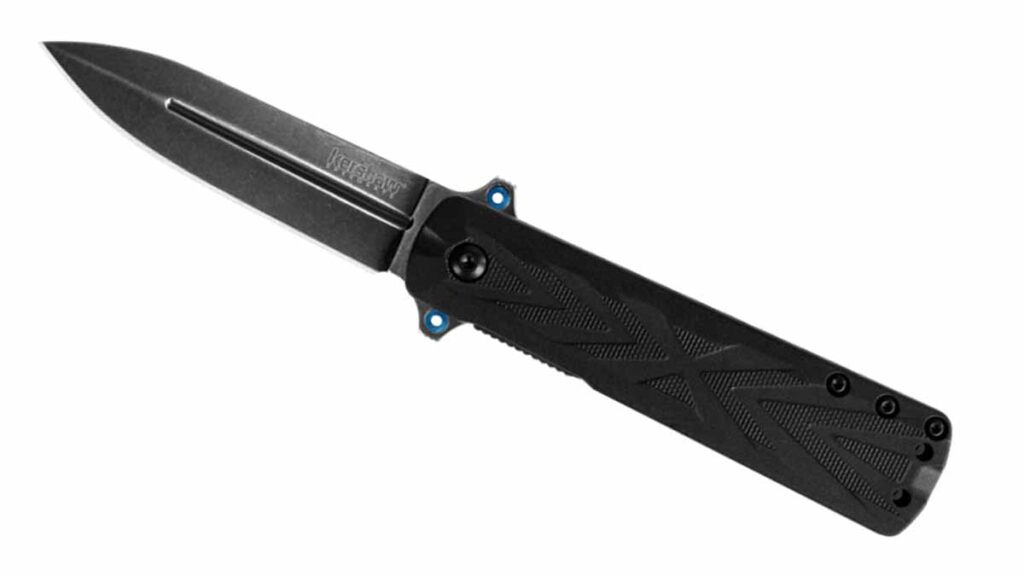
The Kershaw Barstow is a very affordable knife at a suggested retail price of under $40. It features a spearpoint blade and a black-washed finish. For being as inexpensive as it is, it is a true assisted-opening knife and affords the owner a great deal of function at a very low price. While not the highest-end model out there, this low-profile knife will be sure to please.
BLADE LENGTH: 3”
BLADE MATERIAL: 8Cr13MoV stainless steel
OVERALL LENGTH: 7”
HANDLE MATERIAL: glass filled nylon
LOCKING MECHANISM: linerlock
WEIGHT: 3.4 ozs.
MSRP: $39.99
Smith & Wesson M&P SEAR

This attractive and very affordable knife bears the Smith & Wesson logo. Its sheepsfoot blade has a clean, straight edge. Despite its low price, this knife has a great degree of utility and is a welcome companion in the pocket or work bag. The blade profile lends itself to general work, and it shouldn’t draw attention when out in public.
BLADE LENGTH: 2.88”
BLADE MATERIAL: 8Cr13MoV stainless steel
OVERALL LENGTH: 6.89”
HANDLE MATERIAL: Stainless Steel with G10 inserts
LOCKING MECHANISM: Framelock
WEIGHT: 3.8 ozs
MSRP: $39.99
Qygmgs Tactical Folding Knife
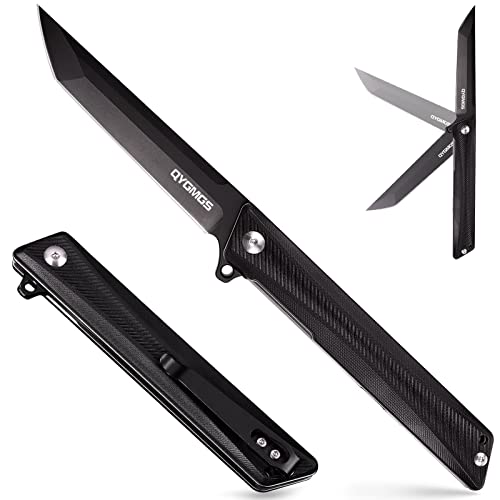
The ‘Amazon Special’ is fashionable and quite affordable. The tanto-style blade comes in serrated and plain-edged varieties. For being as inexpensive as it is, it has an impressive number of features that are extremely well thought out. The handle has an anti-slip texture and is machined from durable G10. The blade pivots on ceramic ball bearings. For being a Chinese import, it punches above its class.
BLADE LENGTH: 3.5”
BLADE MATERIAL: D2 tool steel
OVERALL LENGTH: 8.5”
HANDLE MATERIAL: G10
LOCKING MECHANISM: Linerlock
WEIGHT: 4.2 ozs.
MSRP: $32.67
Benchmade 495 Vector
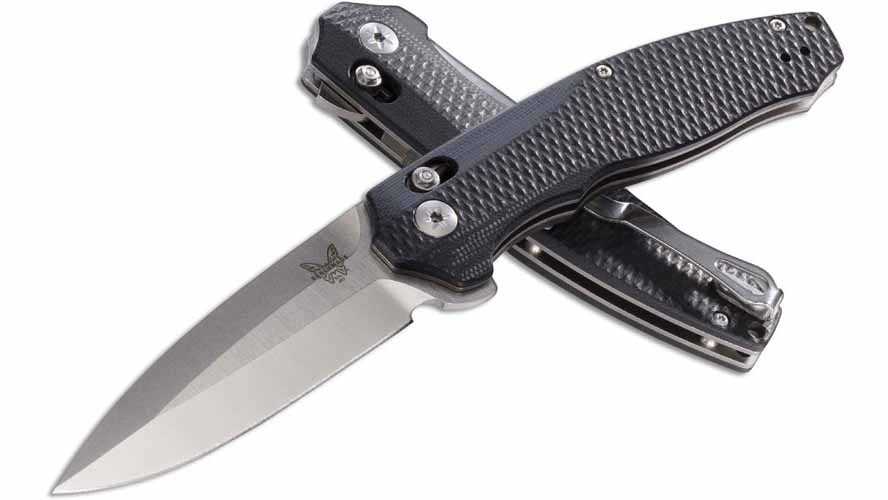
Moving up quite substantially in price is Benchmade’s 495 Vector. This is a symmetrical pocketknife that simply bleeds quality while being fairly low profile at the same time. If you prefer to carry a top-of-the-line design without drawing unwanted attention to yourself, this is going to be a top choice.
BLADE LENGTH: 3.6”
BLADE MATERIAL: CPM S30V stainless steel
OVERALL LENGTH: 8.42”
HANDLE MATERIAL: Contoured G10
LOCKING MECHANISM: AXIS Assist Flipper
WEIGHT: 4.11 ozs.
MSRP: $310
Benchmade Barrage
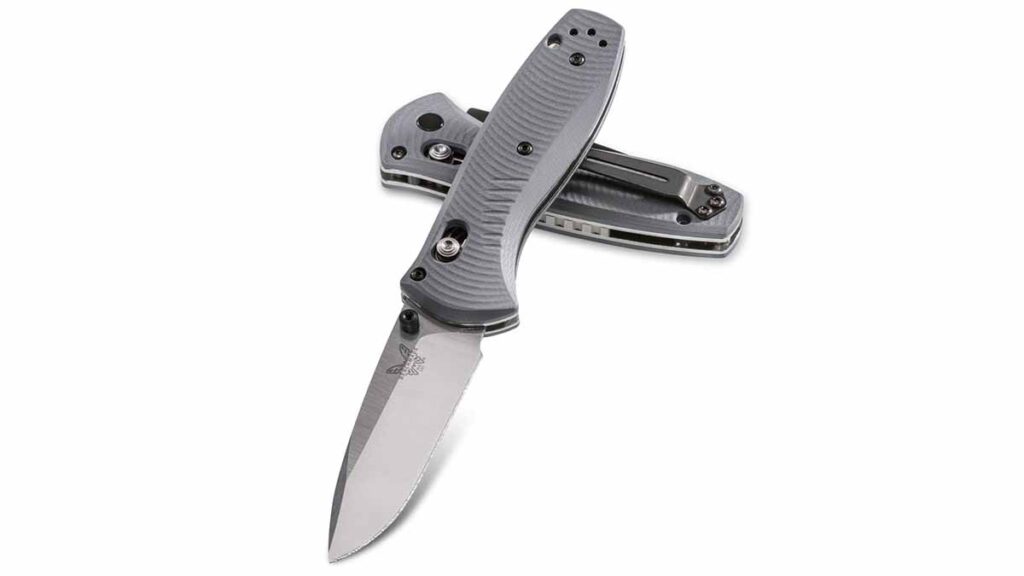
Another top-shelf choice from Benchmade, the Barrage has an aggressive, tactical look that features a plain-edge blade. While it certainly has that bad boy look, it is quite functional in terms of features and utility for cutting tasks at a relatively high cost compared to other assisted-opening folders. If you want top quality and want to look good doing it, this one is hard to beat.
BLADE LENGTH: 3.6”
BLADE MATERIAL: 154CM stainless steel
OVERALL LENGTH: 8.35”
HANDLE MATERIAL: Valox
LOCKING MECHANISM: AXIS Assist Flipper
WEIGHT: 4.51 ozs.
MSRP: $220
CRKT PSD
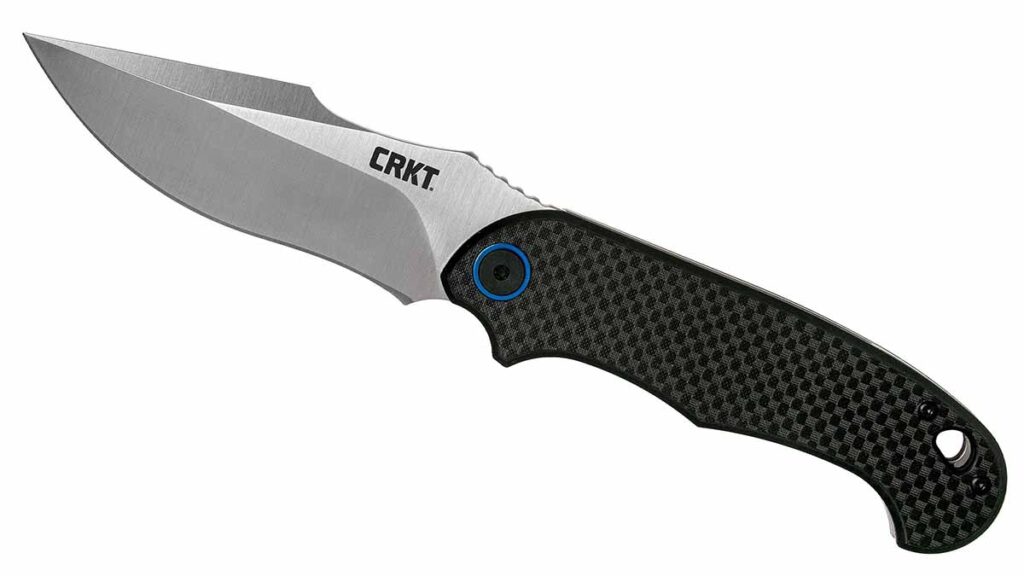
P.S.D. stands for Particle Separation Device, and CRKT’s folder certainly lives up to the futuristic nomenclature. While the materials used in the construction of this knife are becoming more commonplace, it is hard to find them for this price point, and the PSD delivers a very nice, clean appearance for a relatively low cost. CRKT is well known for the quality and affordability of its edged tools, and the PSD is sure to be a favorite come the holidays.
BLADE LENGTH: 3.63”
BLADE MATERIAL: 1.4116 stainless steel
OVERALL LENGTH: 8.19”
HANDLE MATERIAL: Carbon fiber and G10
LOCKING MECHANISM: Linerlock
WEIGHT: 4.6 ozs.
MSRP: $83
Gerber Highbrow
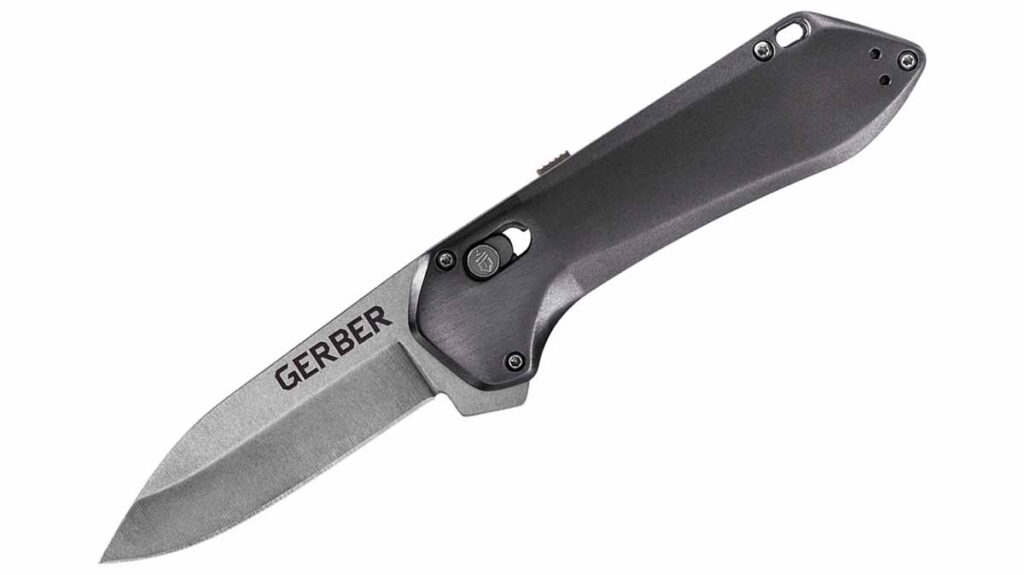
The Gerber Highbrow is ambidextrous and features an easy-to-use sliding lock just under the spine next to the pivot. The edge is plain with a distinct, drop-point profile. At a price of around $50, it is affordable and makes for a good gift for that someone who is worth the extra few dollars around the holidays.
BLADE LENGTH: 3.6”
BLADE MATERIAL: 7Cr17MoV stainless steel
OVERALL LENGTH: 7.9”
HANDLE MATERIAL: Aluminum
LOCKING MECHANISM: sliding blade lock
WEIGHT: 5.97 ozs.
MSRP: $49.60
Boker Plus Kihon
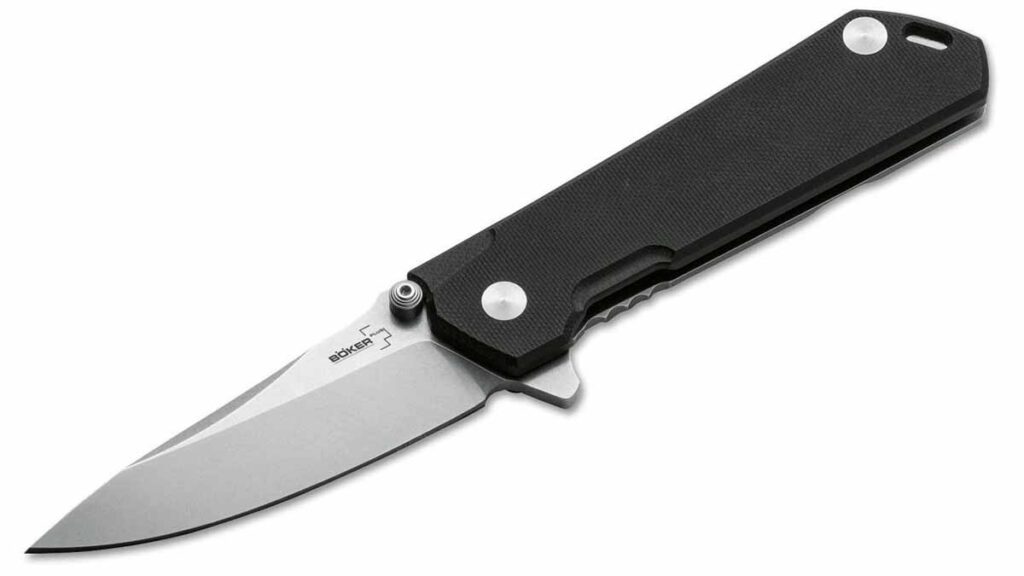
Boker Plus offers the Kihon designed in conjunction with custom knifemaker Lucas Burnley. Lucas is a hot tactical maker whose Japanese-inspired designs have garnered him worldwide acclaim.
The Kihon’s modified clip-point blade is a little over 3 inches long and made from D2 tool steel, long known for toughness and impact resistance. The blade is flat ground for exceptional cutting through a variety of media. A machined recess on the spine serves as a thumb rest to apply pressure and more control. Ambidextrous thumb studs double as the blade’s positive stop when open. A flipper tab offers quick, easy one-hand opening. Caged bearings in the pivot ensure smooth blade rotation.
The handle is a hybrid construction of a stainless steel framelock side mated with a textured OD green G-10 scale for weight reduction and grip enhancement. Gold-colored collars provide a classy visual touch to the pivot and handle screws. A large standoff is also anodized gold to match the other accents.
The lock side features a lockbar stabilizer disc to prevent blade overtravel. A neat wire pocket clip carries the closed knife blade tip up. The blade and steel lock side have a black stonewash finish for low glare and added corrosion resistance. However, the clip is not reversible for lefties. Milled-out oblong cavities in the handle’s lock side reduce weight.
The Kihon is a great EDC. The thumb rest relief helps control the blade, which provides enough length and belly to do most cutting chores. The action is smooth and predictable. Press the flipper, feel the tension load up and the blade propels to the open and locked position.
The assist mechanism performs like the Kershaw SpeedSafe originally designed by BLADE Magazine Cutlery Hall-Of-Fame® member Ken Onion. If you own any SpeedSafe knives then you know how the action is, and the Kihon is very similar in feel. There are no problems with handle comfort, either. The knife is easy to hold and there are no hot spots.
MSRP: $119.95
CRKT Oxcart
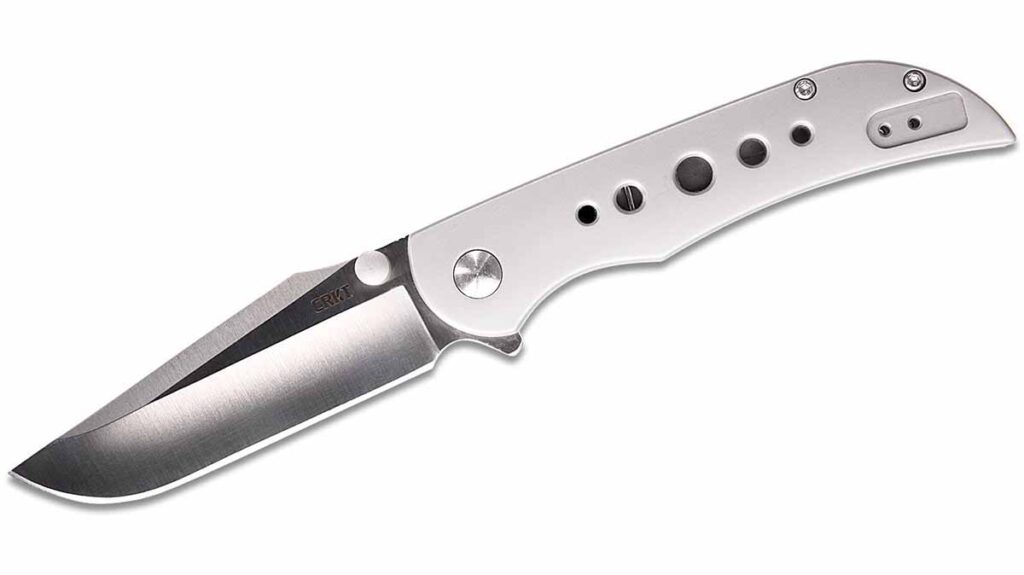
You may snicker at the Oxcart moniker but once you see the knife, you will clearly understand the name. The new entry from CRKT is somewhat of a dichotomy—the handle slab and blade stock thicknesses are what you would normally find on a large, heavy-duty folder, while the Oxcart is compact and slender.
Knifemaker Robert Carter is the designer. He is the son of maker Joe Pardue and grandson of Cutlery Hall-Of-Famer Mel Pardue, so the pedigree is impeccable. The modified clip-point blade is hollow ground from .16-inch-thick AUS-8 stainless steel. The blade is 3 inches, ideal for an EDC work knife. Large dual thumb studs provide purchase for rapid opening, and an extended flipper tab quickly deploys the blade. The blade rides on the Ikoma Korth Bearing System (IKBS) for ultra-smooth action.
The stainless-steel handle is .15 inches thick—about as thick as the blade. Drilled holes reduce weight and enhance aesthetics. A sturdy framelock secures the blade open with bank-vault lockup and zero play. A stabilizer prevents blade overtravel.
A large finger recess enables you to index your grip. The butt tapers to fit the heel of your palm. All handle edges are rounded for further comfort. The deep carry pocket clip positions the closed Oxcart blade tip up and is reversible for lefties. While the heavy-duty build gives the knife impressive heft at 4.7 ounces, it doesn’t weigh you down in the pocket.
As a work knife, the Oxcart shines. The hollow-ground blade bites hard and deep. It is a very efficient cutter. It’s so sharp we had to guard against nicking the wires inside the casing when stripping electrical wire. Due to the extra width of blade and handle, the Oxcart can be used hard without worry that the blade will break or the tip will snap.
One minor complaint with the compact grip: I found myself wanting a bit more to grasp when bearing down to cut through tough materials. However, it being a “compact big knife,” that would ruin the design philosophy. The assist mechanism is CRKT’s multi-wave torsion bar design that provides firm, fast action, with excellent detent closure. A semi-solid push on the flipper overcomes the detent, sending the blade to the locked position in one swift motion.
AUS-8 steel is well known in more moderately-priced knives as having a good balance of edge holding and ease of maintenance. No problems with the steel—it’s a solid performer. I also like how positive the framelock engages, so there are no worries about accidental unlocking. It’s very tight but easy to unlock when needed.
MSRP: $99.99.
Camillus Arvo
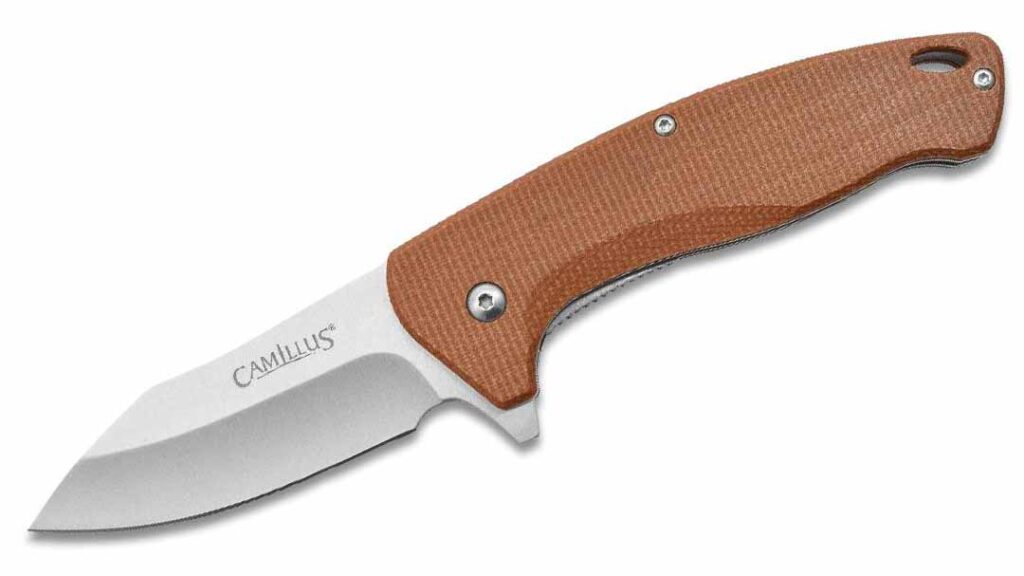
The Camillus Arvo is the most value-conscious of the test group. The 3-inch drop-point blade is made from 420 stainless in a nice satin finish. The blade is utility friendly, with a defined tip for scoring tasks and a belly for most general cutting chores.
The flipper tab extends far enough to function equally as well as a single guard. The sole method of deployment is the flipper; the blade is devoid of thumb studs or discs for a streamlined appearance.
The handle features a typical construction method for tactical folders with dual stainless liners and scales of brown linen Micarta® for strength, high rigidity and dimensional stability, regardless of the elements. The linerlock release has a series of notches for purchase with your thumb when the blade is unlocked. A heavy-duty steel clip provides deep pocket carry of the closed knife in the blade-tip-up position.
The Arvo’s price point is very affordable, which appears to have resulted in a few “oversights.” First, the scales were not finished as smooth as I would have liked. The surface had a texture like peach fuzz from the linen in the Micarta. Don’t get me wrong—having a rougher finish on Micarta isn’t necessarily a bad thing, as the rougher texture aids in grip traction. Nonetheless, the surface finish could be improved.
Second, the edges of the blade spine and flipper tab are crisp. If you are into bushcraft knives, you know that a 90-degree spine is good for striking with a ferro rod to make sparks for fire. However, a 90-degree spine in an EDC folder creates unnecessary sharp corners. Luckily, these can be easily remedied with a metal file and gently rubbing the corners to soften them.
Finally, most flipper folders have the tab with traction notches on it for purchase. The Arvo has no such notches. Otherwise, the knife is a great size for EDC and the handle design is good and comfortable. I love the integral guard formed by the front of the handle at the pivot.
The assist mechanism works very well. Again, judging by the action, I’d say it’s similar to the SpeedSafe torsion-bar type. Deploying the blade is fast and easy. The action is smooth and swift, with the blade riding on Teflon washers. There are no bearings.
The low-end 420 stainless blade steel doesn’t hold an edge nearly as long as even the mid-grade stainless steels such as AUS-8, 8Cr13MoV and VG-10. However, the tradeoff is it’s easier to resharpen. Out-of-the-box sharpness is just OK. I’ve seen better on budget knives and I’ve seen worse. When I put my own edge on it, that’s when performance improved.
At its price point, the Arvo serves well as a work knife. It’s a great alternative to Zytel-handle locking folders and you get upgraded handle material with the Micarta. The hollow grind allows the blade to slice effectively and bite into materials easier. The edge dulls quickly depending on what you’re cutting, so you might benefit from carrying some sort of compact sharpener. And if you end up losing the Arvo, you can buy another one without breaking the bank.
The only thing I found as a slight issue with this particular sample is the blade was off-center a bit when closed. Given the low price, I am more forgiving of such things. However, it has no bearing on the action or cutting performance. The lockup is firm and sure.
There’s a lot of features going for this knife for the price: Micarta handle, deep carry pocket clip, flipper tab, assisted opening and open handle spine. Many of these features are found in knives priced way higher.
MSRP: $27.99
Pro-Tech TR-5 SA
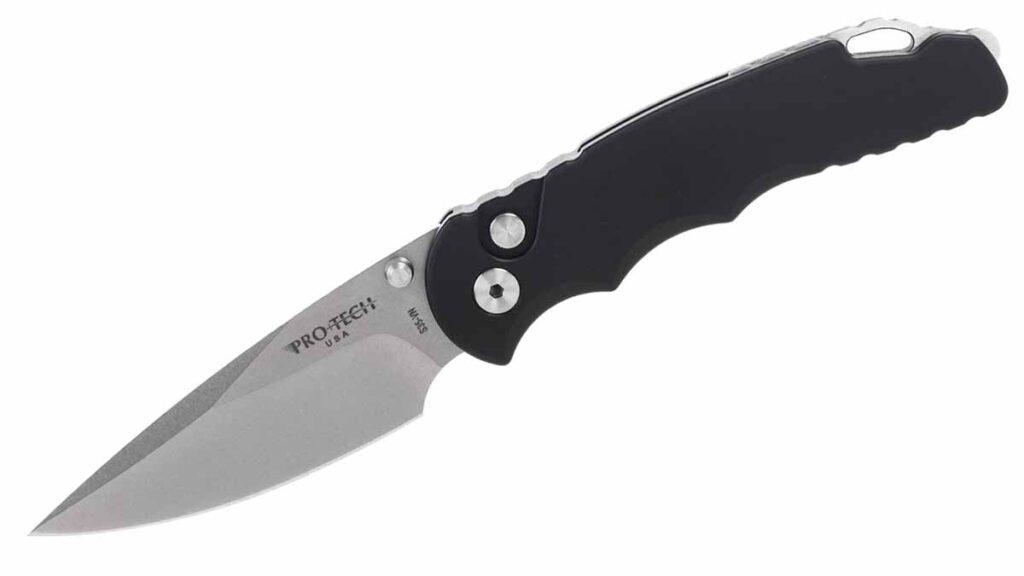
Known widely for autos, Pro-Tech offers an assisted opener with the TR-5 SA. Essentially a scaled-down version of the company’s TR-4, it has tactical styling, superior materials and a distinctive spring-assist mechanism.
The 3.25-inch blade is CPM S35VN high-performance stainless. The modified drop-point pattern has flat-ground main bevels with a swedge added for a bit of attitude. A single thumb stud helps open the knife. The blade comes in a nice stonewash finish that hides scratches and helps resist corrosion.
The handle features rounded ends and a tapered design from pivot to butt. Several large finger grooves help seat your hand securely, along with a series of traction notches following the three finger grooves.
On the handle spine, traction notches are milled into the thumb rest for a non-slip grip. The handle spacer is milled from 416 stainless and also has traction notches to enhance grip. The end of the spacer protrudes a bit at the butt, forming a skull crusher pommel.
The handle slabs are T6-6061 aluminum given a Type III hard anodized black coat for scratch resistance and aesthetics. A deep carry pocket clip presents the closed knife blade tip up. When clipped in the pocket, none of the knife protrudes above the seam.
The handle feels very comfortable and instills user confidence, with no hot spots. Pro-Tech’s high standards for manufacturing excellence carry over into its base models with plain aluminum handles such as this one. The pivot screw and lock button sport spun finishes that reflect light in a refined manner. It’s such nice little touches that set Pro-Tech apart.
The assist mechanism is different from other assisted openers. For starters, it uses the same coil-spring design that drives the company’s automatics. If you’ve handled a Pro-Tech auto, you know it has a strong spring and a nice recoil. The same goes for the TR-5 SA.
There’s an additional component to the mechanism designed by award-winning maker Matthew Lerch: an unusual spring-loaded detent that holds the blade closed. The result is a strong detent that requires a firm push of the thumb stud to overcome; from there the coil spring takes over and drives the blade open. As a result, you get the legendary Pro-Tech action for those who cannot legally buy autos. The action is indeed the fastest of the featured assisted openers and, I believe, the fastest on the market.
MSRP: $300
Dexter Ewing contributed to this piece.
Read More
- Daggers: Immortal Icons
- Gravity Knives
- Utility Knives
 NEXT STEP: Download Your Free KNIFE GUIDE Issue of BLADE Magazine
NEXT STEP: Download Your Free KNIFE GUIDE Issue of BLADE Magazine
BLADE’s annual Knife Guide Issue features the newest knives and sharpeners, plus knife and axe reviews, knife sheaths, kit knives and a Knife Industry Directory.Get your FREE digital PDF instant download of the annual Knife Guide. No, really! We will email it to you right now when you subscribe to the BLADE email newsletter.






